Getting The Most From OneDrive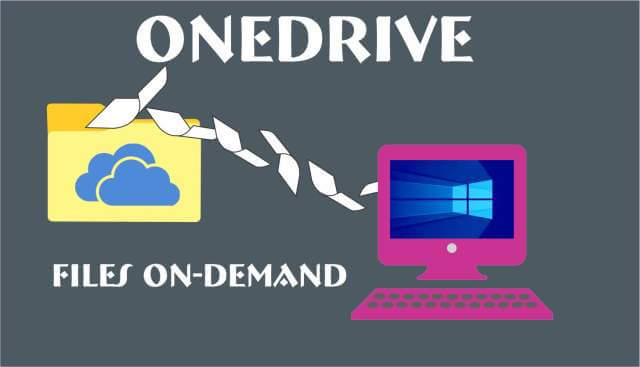
Assuming you have Microsoft Office 365 and the free 1TB of storage it can be a great tool when saving your photos or videos. 1TB can hold thousands of photos, videos, and documents letting you reduce your phone and computer’s storage space while always being available on your phone if you have the OneDrive App installed.
When you take photos or videos on your mobile device, they are not automatically uploaded to OneDrive. However, you can either choose to manually upload photos from your mobile device or set them to automatically upload to the Camera Roll folder on OneDrive.
Manually: If you have OneDrive on your PC, tap on the phone’s camera icon, and choose to take a photo or upload an existing one. Generally, it should only take a few minutes for the file to sync with OneDrive. It can take up to 30 minutes on some devices based on the speed of your Wi-Fi, and the size of the photo, phone, or PC.
Automatic: If you want automatic Camera Roll uploads, you can set it up in the OneDrive settings by clicking on the OneDrive icon and entering settings, while sync and backup are highlighted, toggle on Save photos and videos from devices. If you only want to back up your photos and not your videos, you can choose to manage your backup settings and exclude any of the listed items.
Syncing files from your phone to OneDrive also downloads them to your PC. If you have limited storage, this is where Files On Demand comes in handy.
Files On Demand
Files On Demand allows you to upload your files from your PC and devices and keep them only in the cloud. The best part of this is they are still always available to you on OneDrive but are no longer taking up valuable disk space on your PC. Once you choose Files On Demand, your OneDrive and PC Folders will look different.
Even if you choose to remove them from your mobile devices after they are uploaded to the cloud, they will still be available on OneDrive.
How it works – by default, OneDrive downloads files to your PC the first time you open them. Files On Demand helps you access all your files directly from the cloud without having to download them to your computer. You will see all your files as online-only files in File Explorer but you must be connected to the internet. Unless you are in an area with spotty internet, this should not be an issue.
An added benefit is you can still select files and folders to always be available, even if you are offline. Selected files will be downloaded and reside both in the cloud and on your PC.
If you delete files, online-only files in OneDrive will hold them in the OneDrive recycle bin for 30 days and up to 93 days with a work or school account.
Enabling Files On Demand
Click on the cloud icon in your system tray, then click on the gear icon at the top of the menu. Click on the gear icon again to open OneDrive settings.
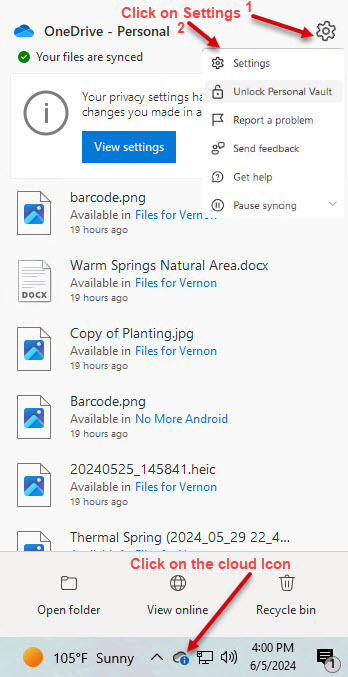 With Sync and Backup highlighted, click on Advanced Settings and scroll down to access the Files On-Demand section. Clicking on Free up disk space will open File Explorer where you can choose which files you want to have stay in the cloud.
With Sync and Backup highlighted, click on Advanced Settings and scroll down to access the Files On-Demand section. Clicking on Free up disk space will open File Explorer where you can choose which files you want to have stay in the cloud.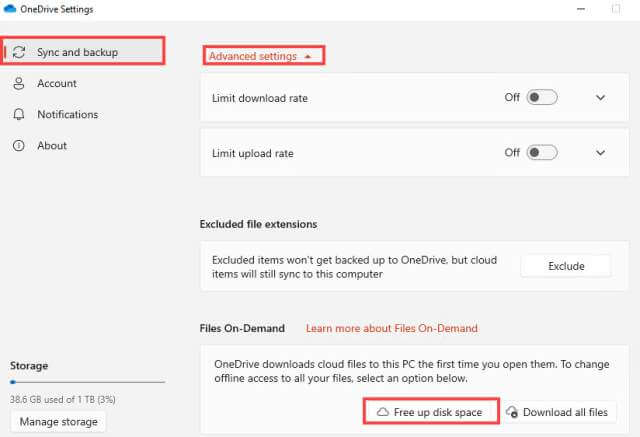
Managing Excluded File Extension
You may also exclude certain file types by clicking on the Exclude button shown in the image above and entering the file extension you do not want to be backed up to OneDrive. Any items with that extension will not be uploaded to OneDrive. Any files with that extension already on OneDrive will still sync to the computer.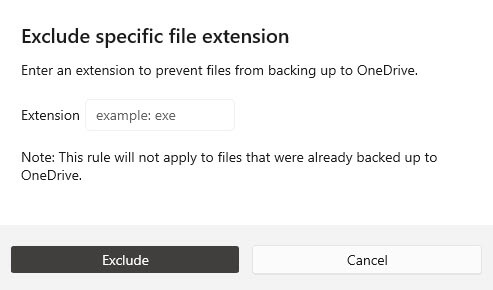
Managing Your Backup Folders
With Sync and Backup highlighted, click on Manage Backup. A second screen will open where you can toggle on the folders you want to be backed up to Onedrive.
Summary
When you select Files On-Demand your files are removed from your PC’s storage but remain on OneDrive. They are not removed from your phone’s Gallery. You may manually delete the photos in your Gallery while keeping a copy on OneDrive. Using the OneDrive App on your phone allows you to view any files stored on OneDrive even if it is no longer on your phone. If you add additional storage later, you can repeat the steps to access the File On-demand section but choose Download all files. Every file in the cloud will be downloaded to your computer but not to your phone.
—


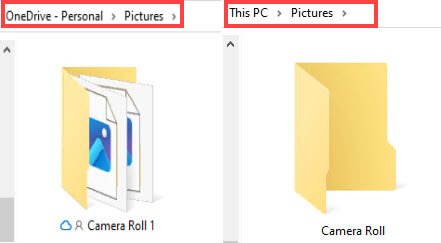
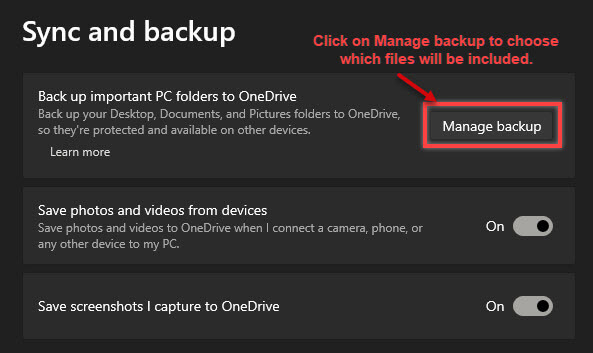
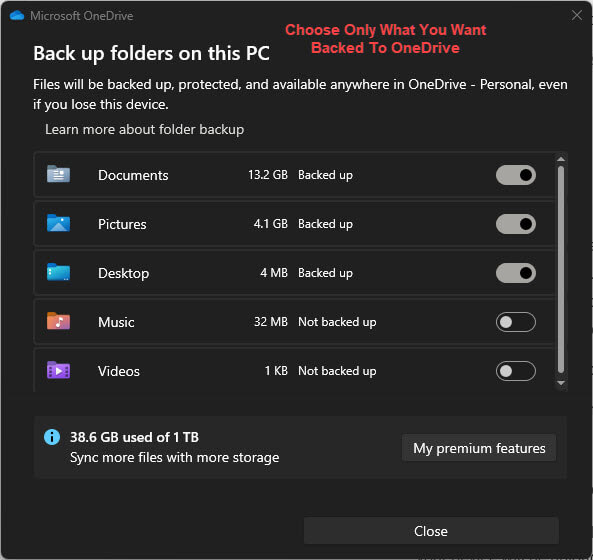
This article only applies to those who have Microsoft Office 365, correct?
I don’t have MSO365 and don’t see the ‘i’ on the cloud icon in the system tray.
Thanks,
Dan
Every Windows user has OneDrive. It is an integral part of Windows, but new purchases of Windows are only 5GB of storage and 15GB of mailbox storage, as long as you have a Microsoft account. The purchase of 365 only increases the size of OneDrive If you have been a Windows user with Hotmail or Outlook for a long time you might have 15GB which used to be the minimum. Any referral that mentions you will give you both an additional 500MB of storage. 1GBB split between you up to 10GB. You can purchase OneDrive only which they call Microsoft 365 Basic for $20 per year. You get 365 but online only. For $70 per year Office Plus 1TB. For 100 per year 1TB per person for six people. One way to minimize the cost is to have six people share the cost and get 1TB each for only $16.66 per year.
Thanks, Jim – I do have 15GB since I was/am a Hotmail user.
Thanks for the account details but I was wondering why I don’t see the ‘i’ on the system-tray cloud icon when I get to the section in your article: “ENABLING FILES ON DEMAND” (with the red arrow pointing to CLICK ON THE CLOUD ICON).
Dan
I have a different ‘syncing’ issue with OneDrive: my Excel file syncs to the cloud just fine but when I open Excel the next time it shows the same file with 2 different timestamps: one on the cloud and one on my SSD (which is a little confusing even though they should be the identical file). Is there a way to tell Excel to only display the file on my SSD?
Thanks,
Dan